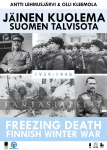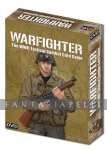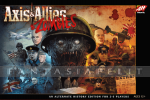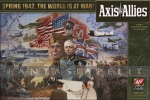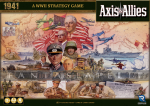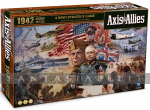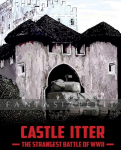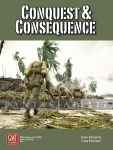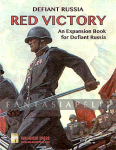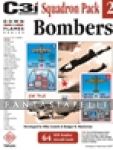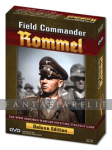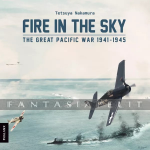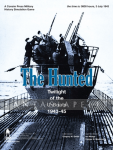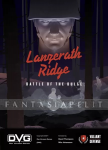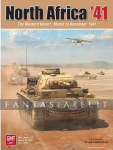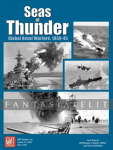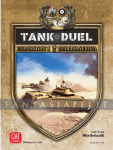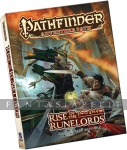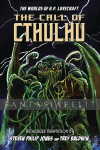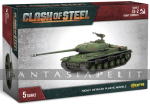World War 2 was the largest and most violent extended naval war in history. From September 1939 until the surrender of Japan, the high seas were a global battle zone filled with mighty battleships, nimble cruisers, silent hunters, and flat-tops bristling with planes. Before our eyes, we witnessed the changing of warfare on the high seas as the thunderous old guard fell to air power and submarines Raiders prowled the open waters and the carrier showed its true diversity and adaptability.
Seas of Thunder not only allows players to re-create the Atlantic or Pacific theaters of the war but to see how challenging the entire picture was for their leaders. How do you protect a globe from German raiders? How desperate was it for Britain when France fell and they were left to fight Germany and Italy alone on the high seas? What is the right balance for the Soviet fleet split between for distinct fronts (Baltic, Black Sea, Arctic, and Pacific)? If the Mediterranean force weakens for the allies, where to they draw ships. from? Does Japan strike quickly or play for attrition when they arrive on the halfway point? Will America fight in two fronts, three, or four?
In Seas of Thunder, players will experience the tension of too much sea to cover with too few ships, the frustration of being caught unprepared, or the intensity of a vital stand contesting a high-value sea area. Victory is neither sudden nor guaranteed. In each battle, a flight of Catalinas, the lack of ASW, the improper distribution of air power, or even a missing minesweeper could be the difference between success or failure.
Seas of Thunder is every bit a full-force strategic-level representation of the conflict on the high seas during World War 2. Players have to manage a global disposition of their warships with frequently too much ocean to cover and not nearly enough ships to cover it.
Each nation has access to the historical ships that sailed in the conflict. Each country's fleets have advantages and disadvantages that are unique to them.
Germany: Small surface fleet but complemented with an ever-expanding force of Submarines. Reliance on Armed Merchant Raiders that can strike all over the globe. Additionally their use of Neutral ports allows them great flexibility in setting up their plans and forcing the Allies to respect the entire battlefield.
Great Britain: Superior warships in quantity but not as new as the German Fleet in general. All of the ships operationally tied to a global network of bases. Care and forethought is required at the start of each game regarding their deployment , as re-deployment will be challenging.
France: Quality Ships that will be bounced from side-to-side over the course of a game. Their disadvantage is moving first and opening themselves up to being savaged each time they leave port.
Italy: Has strong ships and local superiority in the Mediterranean. A lack of wartime building means that Italian losses are not replenished at the rate the Allies are, so each loss feels more permanent and damaging.
Soviet Union: Respectable ships and submarines are countered by the fact that they are forced into restrictive fights on three or four fronts (Baltic Sea, Arctic Ocean, Black Sea, and Pacific Ocean). Each of these fights are usually balanced agains the Russians, but they must at least threaten on all of them to alleviate pressure on the other Allies.
Japan: Begins the war with a huge fleet of varying and unique ships. They are easily a match at first for any opponents. As the war progresses, the USA and UK begin to rise up and challenge them for dominance. The Japanese player has to understand their limits and not over-reach with what feels like unstoppable power.
USA: Starts off the game with plenty of ships and plenty of holes to fill. The Pacific is brutal with Japan processing so much power. But the Mediterranean needs shored up, not to mention the Atlantic war against the U-boats. "Over-reach" will be the watchword for the day as the American commander. As the game progresses, the power shifts in your favor, as do the responsibilities.
Objectives and Scoring
At its heart, Seas of Thunder is a large area control game where the Allies score low numbers of points for control and the Axis score higher per area. Controlling 6 Areas for the Allies may not be as valuable as scoring 1 area for the Axis. The Axis player seeks to win key zones, and the Allied player must make them pay dearly for them.
The game is divided up into 7 smaller scenarios or campaigns that can be played '"as-is" or combined to fight a portion of the war all they way up to the entire campaign.
Points are scored each turn for the following:
* Variable points per Sea Zone controlled
* Each Convoy of the opponent Sunk
* Each Enemy Warship Sunk
* Each Land-Based Air Unit not used (and thus allowed to participate in the ground war or strategic bombing)
Historical Authenticity
Ok, you know me, so of course we had to make a couple of adjustments to the historical realities to make the game the best competition between two sides. Most of this was done with just adjusting the scoring to keep scenarios balanced. In addition, we tweaked the time periods to allow for a more precise entry and removal of powers at the start and end of scenarios.
The French and Vichy were a difficult choice but we allowed them to perhaps more flexibility than they historically executed. Players can keep them in port, preserve them, and score their points when they flip first to Axis, then back to the Allies. Or they can use them above and beyond what they historically did. We have also elected to keep the Free French ships out of the game and "interred" while the Vichy are active to avoid confusion.
We will be publishing a number of InsideGMT articles with all of our historical vs gameplay decisions mapped out, some may already be listed above when you read this.
Various Strategies
What we really tried to do in Seas of Thunder is to allow players to have multiple levers to control and manipulate
Base Deployment is important and cannot be overlooked. Placement of your ships at the start of the game is of crucial importance. Some nations are more difficult to handle than others, and the British are perhaps the most tied to their starting locations.
Operational Disposition becomes key on both sides. The sides going first must keep forces strong enough to contest sea zones but not so powerful that the strength becomes wasteful. The latter moving side, usually the Axis, must pick and choose where to appear in strength, where to raid, and where to avoid.
Individual ship functions need to be balanced and are the key to winning every battle. A mass of battleships becomes vulnerable to submarines and air. Submarines are vulnerable to carriers and destroyers but only if they are on ASW patrol. Carriers have quick-strike opportunities but become floating targets if their strikes fail. Minelayers are the scourge of the sea for everyone, unless, of course, you have the otherwise useless minesweepers with you. You can call it a rock-paper-scissors approach if you like, but if you are a short piece of paper, you may get smashed by a rock.
Seas of Thunder is the first game I have played that truly lets me understand the tightrope walked by both sides in the war. How gloriously open the war seemed but how restricted it truly was. Chuck, Neal, and I feel that we have given players the perfect opportunity to compete against each other in a game that truly reflects the challenges faced by the commanders. We have had great fun testing it for three straight years, and we hope you have the same enjoyment playing it.
What's in the Box
* Seas of Thunder may not have every ship in the conflict, but it has the ones you know.
* 1 Mounted Map (Double-Sided with pre-Pearl Harbor scoring on one side and post-Pearl Harbor scoring on the other)
* 1200+ Combat Ship counters (Capital ships down to Destroyer Squadrons, Submarine Grops, and Mine-sweeping Flotillas)
* 132 Convoy & Utility counters
* 14 Port Cards (1 per side for each of 7 scenarios)
* Combat Sequence Cards for tracking combat
* Plus sundry dice, rules, scenario details... the usual.
Game Design: Jeff Horger, Charles Maher, and Neal Cebulskie








